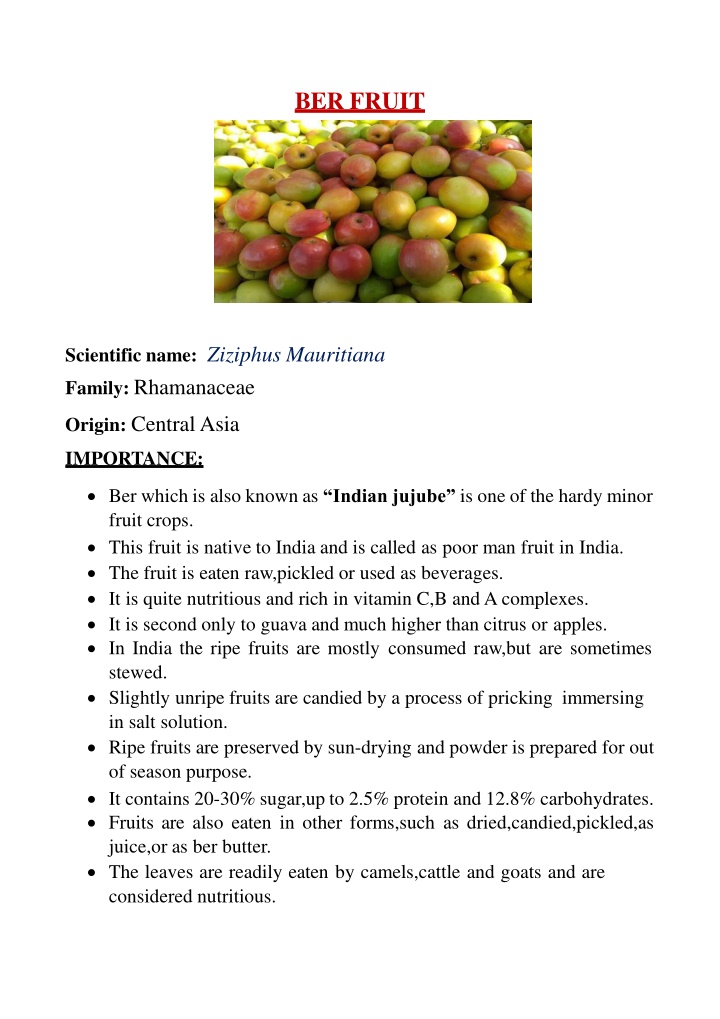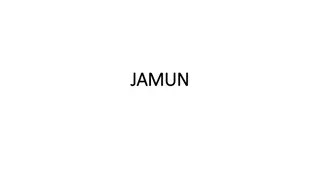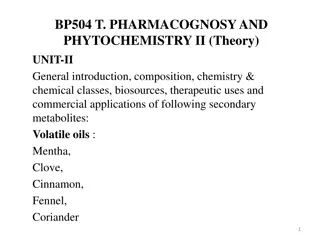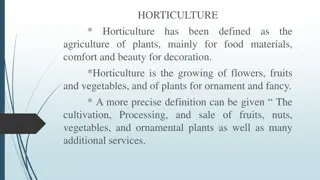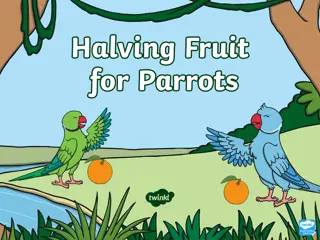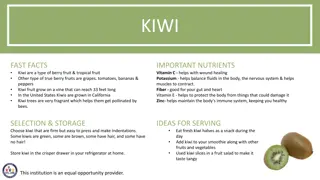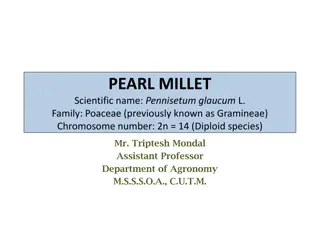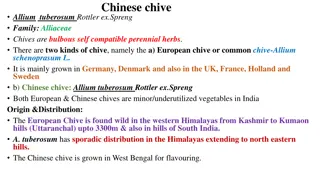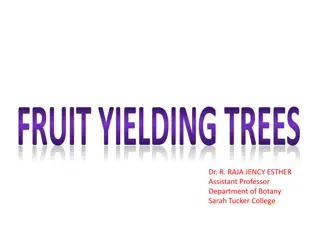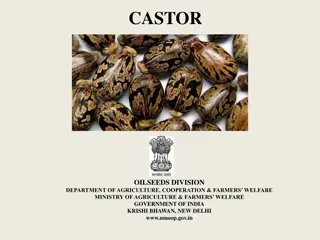All About Ber Fruit: Cultivation, Nutritional Value, and Uses
Ber fruit, scientifically known as Ziziphus Mauritiana, is a hardy minor fruit crop native to Central Asia. Also called Indian jujube, it is popular in India for its versatility in consumption - raw, pickled, or as beverages. Ber is rich in essential nutrients and widely used in various forms such as dried, candied, or juiced. The tree thrives in various soil types and climates, making it a resilient crop. Learn about propagation, planting, training, and pruning techniques for successful cultivation. Know about the nutritional benefits, medicinal uses, and economic importance of this nutritious fruit.
Download Presentation

Please find below an Image/Link to download the presentation.
The content on the website is provided AS IS for your information and personal use only. It may not be sold, licensed, or shared on other websites without obtaining consent from the author.If you encounter any issues during the download, it is possible that the publisher has removed the file from their server.
You are allowed to download the files provided on this website for personal or commercial use, subject to the condition that they are used lawfully. All files are the property of their respective owners.
The content on the website is provided AS IS for your information and personal use only. It may not be sold, licensed, or shared on other websites without obtaining consent from the author.
E N D
Presentation Transcript
BER FRUIT Scientific name: Ziziphus Mauritiana Family:Rhamanaceae Origin: Central Asia IMPORTANCE: Ber which is also known as Indian jujube is one of the hardy minor fruit crops. This fruit is native to India and is called as poor man fruit in India. The fruit is eaten raw,pickled or used as beverages. It is quite nutritious and rich in vitamin C,B andA complexes. It is second only to guava and much higher than citrus or apples. In India the ripe fruits are mostly consumed raw,but are sometimes stewed. Slightly unripe fruits are candied by a process of pricking immersing in salt solution. Ripe fruits are preserved by sun-drying and powder is prepared for out of season purpose. It contains 20-30% sugar,up to 2.5% protein and 12.8% carbohydrates. Fruits are also eaten in other forms,such as dried,candied,pickled,as juice,or as ber butter. The leaves are readily eaten by camels,cattle and goats and are considered nutritious.
In India and Queensland, the flowers are rated as a minor source of nectar for honeybees. The honey is light and of fair flavour. Bertimber is hard,strong,fine-grained,fine-textured,tough,durable and reddish in colour. It is used to line wells,tool handles,boat ribs,and agricultural implements. The frits are applied on cuts and ulcers which are employed in pulmonary ailments and fevers. Theses are also mixed with salt and chili pepper and are given in indigestion and biliousness. The seeds are sedative and are taken sometimes with buttermilk, to hault nausea, vomiting and abdominal pains in pregnancy. SOILS: The ber tree grows on a wide range of soils ranging from shallow to deep and from gravelly and Sandy to clay. The tree is very hard and thrives well in poor soils as well. It also tolerates alkalinity and slightly waterlogged conditions. CLIMATE: This fruit is hardy fruit and grows well under any climatic conditions and up to an elevation of 1100 meters above mean sea level. For best production, this fruit crop requires hot and dry climatic conditions. The best fruit crop tolerates high temperature and aridity by cessation of growth, leaf fall and dormancy stage. VARIETIES: Umran, Karaka, Sanaur-2, Gola, Chhuhara, Mehrun, Seb, Kaithali, and Banarasi. Among all these varieties Umran is the best one in terms of quality. PROPAGATION: Ber is raised by both through seed and vegetative means.
We can propagate the ber through seed also buy it takes one month to germinate and bearings takes place at 6-11 years. So, the most common vegetative method of propagation is by I or T (shield) budding Root stock seedlings are raised by sowing seed kernels extracted by breaking the stone (endocarp). These germinate in about one week PLANTING: Before planting the land should be cleared and levelled. Planting is done during june-August with a spacing of 7 7 m in pits of 60 60 60 cm size. For Kaithali, 8 3 m and for Banarasi 8 4 m spacing is followed. TRAININGAND PRUNING: Remove the root stocks and have a straight stem up to 75 cm from the ground level. It is very important in early years to build up a strong framework and in later years to maintain vigour to improve fruit size and quality. During February- March, prunethetrees andthinthecrowded branches to provide maximum fruit bearing area in the tree. MANURESAND FERTILIZERS: Manuring should be done immediately after pruning. Spray 2% KNO3 thrice at monthly intervals in January, February and March. Manures and fertilizers FYM(Farmyard manure) N 200 g P 100g K 200g 1styear 2ndyear on wards 20 kg 50 kg 500g 200g 500g
IRRIGATION: Generally, ber trees are cultivated under rainfed conditions. However, in case of irrigated crops, watering should be done based on soil moisture condition and weather conditions. In hot long dry season, irrigate the field twice a month. INTER CULTURE: Land should be prepared by ploughing, harrowing,fine levelling and removing any weeds. Raising of cover crops or inter crops is very beneficial. INTER CROPPING: Farmers can utilize the inter spacing in ber plantation for getting extra revenue. Under irrigated conditions, any vegetables crops can be grown as intercrops until the ber trees are fully grown (3 to 4 years). Under rain fed conditions, legume crops like Moong (mung bean), cowpea and horse gram can be grown. HARVESTING: Usually, ber tree will be ready for harvesting in 5 to 6 months after flowering. To get early fruits, spray 750 ppm , 2-chloro-ethyl phosphoric acid. The time of harvesting depends on the region in India, October to November in South India. December to March in Gujarat. January to March in Rajasthan and February toApril in North India. Under rain fed conditions, fruits bearing starts from 2ndyear. Where as budded plants will be ready for bearing after 3-4 years. YIELD: The fruit yield depends on the farm management practices, variety and climatic conditions.
The average yield of 100 to 200 kg / tree can be expected during prime bearing stage (10 to 20 years). In rainfed conditions an average yield of 60 to 90 kg can be obtained. Ber tree is productive for 20 to 30 years.
